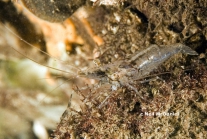
| Intro | | Search taxa | | Browse taxa | | Distributions | | Terminology | | References | | Statistics | | Online sources | | Tutorial | | Log in |
ERMS taxon detailsPalaemon macrodactylus Rathbun, 1902
181372 (urn:lsid:marinespecies.org:taxname:181372)
accepted
Species
marine, brackish,
recent only
Rathbun, M.J. (1902). Japanese stalk-eyed crustaceans. <em>Proceedings of the United States National Museum.</em> 26: 23-55., available online at https://www.biodiversitylibrary.org/page/7612066
page(s): 52 [details]
DecaNet eds. (2025). DecaNet. Palaemon macrodactylus Rathbun, 1902. Accessed through: Costello, M.J.; Bouchet, P.; Boxshall, G.; Arvanitidis, C.; Appeltans, W. (2025) European Register of Marine Species at: http://www.marbef.org//www.marbef.org/data/aphia.php?p=taxdetails&id=181372 on 2025-04-26
Costello, M.J.; Bouchet, P.; Boxshall, G.; Arvanitidis, C.; Appeltans, W. (2025). European Register of Marine Species. Palaemon macrodactylus Rathbun, 1902. Accessed at: http://www.marbef.org//www.marbef.org/data/aphia.php?p=taxdetails&id=181372 on 2025-04-26
Date action by
original description
Rathbun, M.J. (1902). Japanese stalk-eyed crustaceans. <em>Proceedings of the United States National Museum.</em> 26: 23-55., available online at https://www.biodiversitylibrary.org/page/7612066
page(s): 52 [details] context source (Introduced species) Katsanevakis, S.; Bogucarskis, K.; Gatto, F.; Vandekerkhove, J.; Deriu, I.; Cardoso A.S. (2012). Building the European Alien Species Information Network (EASIN): a novel approach for the exploration of distributed alien species data. <em>BioInvasions Records.</em> 1: 235-245., available online at http://easin.jrc.ec.europa.eu [details] Available for editors context source (Schelde) Maris, T., O. Beauchard, S. Van Damme, E. Van den Bergh, S. Wijnhoven & P. Meire. (2013). Referentiematrices en Ecotoopoppervlaktes Annex bij de Evaluatiemethodiek Schelde-estuarium Studie naar “Ecotoopoppervlaktes en intactness index”. [Reference matrices and Ecotope areas Annex to the Evaluation methodology Scheldt estuary Study on “Ecotope areas and intactness index”. <em>Monitor Taskforce Publication Series, 2013-01. NIOZ: Yerseke.</em> 35 pp. (look up in RoR) [details] basis of record d'Udekem d'Acoz, C.; Faasse, M.; Dumoulin, E.; De Blauwe, H. (2005). Occurrence of the Asian shrimp <i>Palaemon macrodactylus</i> in the Southern Bight of the North Sea, with a key to the Palaemonidae of north-western Europe (Crustacea: Decapoda: Caridae). <em>Ned. Faunist. Meded.</em> 22: 95-111. (look up in RoR) [details] additional source González-Ortegón, E.; Cuesta, J.A. (2006). An illustrated key to species of <i>Palaemon</i> and <i>Palaemonetes</i> (Crustacea: Decapoda: Caridea) from European waters, including the alien species<i> Palaemon macrodactylus</i>. <i>J. Mar. Biol. Ass. U.K. 86(1)</i>: 93-102 (look up in RoR) [details] additional source Liu, J.Y. [Ruiyu] (ed.). (2008). Checklist of marine biota of China seas. <em>China Science Press.</em> 1267 pp. (look up in RoR) [details] Available for editors additional source De Grave, S.; Fransen, C.H.J.M. (2011). Carideorum catalogus: the recent species of the dendrobranchiate, stenopodidean, procarididean and caridean shrimps (Crustacea: Decapoda). <em>Zoologische Mededelingen, Leiden.</em> 85(9): 195-589. (look up in RoR) [details] additional source Zenetos, A., Gofas, S., Morri, C., Rosso, A, Violanti, D., Garcia Raso, J. E., Cinar, M. E., Almogi-Labin, A., Ates, A. S., Azzurro, E., Ballesteros, E., Bianchi, C. N., Bilecenoglu, M., Gambi, M. C., Giangrande, A., Gravili, C., Hyams-Kaphzan, O., Karachle, P. K., Katsanevakis, S., Lipej, L., Mastrototaro, F., Mineur, F., Pancucci-Papadopoulou, M. A., Ramos Espla, A., Salas, C., San Martin, G., Sfriso, A., Streftaris, N., and Verlaque, M. (2012). Alien species in the Mediterranean Sea by 2012. A contribution to the application of European Union's Marine Strategy Framework Directive (MSFD). Part 2. Introduction trends and pathways. <em>Mediterranean Marine Science.</em> 13(2): 328-352. [details] Available for editors additional source Marchini, A., J. Ferrario, A. Sfriso & A. Occhipinti-Ambrogi. (2015). Current status and trends of biological invasions in the Lagoon of Venice, a hotspot of marine NIS introductions in the Mediterranean Sea. <em>Biological Invasions.</em> 17:2943–2962., available online at https://doi.org/10.1007/s10530-015-0922-3 [details] Available for editors  Present Present  Inaccurate Inaccurate  Introduced: alien Introduced: alien  Containing type locality Containing type locality
To Barcode of Life (127 barcodes)
To Biodiversity Heritage Library (8 publications) To Biological Information System for Marine Life (BISMaL) To European Nucleotide Archive, ENA (Palaemon macrodactylus) To GenBank (136 nucleotides; 138 proteins) To Information system on Aquatic Non-Indigenous and Cryptogenic Species (AquaNIS) To NHMUK collection (Palaemon macrodactylus Rathbun, 1902; NON-TYPE; NHMUK:ecatalogue:9505842) To Niet-inheemse soorten Belgisch deel Noordzee en aanpalende estuaria (in Dutch) To PESI To USNM Invertebrate Zoology Arthropoda Collection (2 records) To Yale Peabody Museum of Natural History (YPM IZ 097417) To ITIS |



